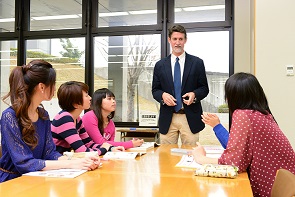キャンパスリポート
Conversation Projects in Second Language Acquisition (第二言語習得) Class
2016年2月5日
今回のリポートでは、本学で開講されている “Second Language Acquisition”(第二言語習得)の授業と、授業の中で学期中に学生達が取り組む課題について紹介します。同科目は英語で行われる専門科目の一つです。英語での講義や学生独自の調査・研究を通して、言語が如何にして機能するかを深く理解し、言語に関するデータを分析する方法を学びます。学生達は主に会話文の言語学的分析を行います。またリポートの最後に述べられていますが、第二言語習得を専門的に学んで得た知識は、学生自らが英語で話す際にも活きてきます。
Students in my Introduction to Second Language Acquisition class participate in three projects during the semester. During my class, as in most traditional courses, students listen to lectures and complete readings from our textbook. The information they learn is then put to use in our conversation projects. In these projects, students have a chance to gain real hands-on experience working with actual language data. Participation in these projects helps students gain a deeper understanding of how language works and teaches them how to analyze real language data in the same way a trained linguist would do. All of the projects are designed to teach students the basics of linguistic analysis focusing on conversations. Additionally, students can attain a deeper understanding of some of the issues learners face as they acquire a new language. Here, I will talk briefly about the third and final project.
The third project involves each student transcribing (writing what is said) and analyzing a video of a young English speaking child who is acquiring Japanese. In the videos, the child is speaking in Japanese to a college-aged Japanese person. The conversation is not scripted or planned, it is a natural interaction. Since the child is not completely fluent in Japanese, it is not difficult for students to find language issues to analyze. Students also have a chance to collaborate and help each other as they think about how to best analyze the language in their video.
During our SLA class, the students learn about various issues in second language acquisition, including the acquisition of grammatical features and the influence of the social environment in the use of language by learners. For this project, working with their native language allows my students to see concrete examples of these issues in a real world context. The students, in other words, are able to see how the information they learn in lectures and from the textbook is realized in an actual learner’s language.
At the end of this project, students appreciate how much they have learned about the difficulty of learning a new language. This helps them understand and appreciate their own efforts at learning English in a new way. Also, after watching a learner make many mistakes, but still produce understandable language, my students often report that they feel less afraid to make mistakes when they are speaking English.
Timothy Gould, Associate Professor, Department of English
]]>
